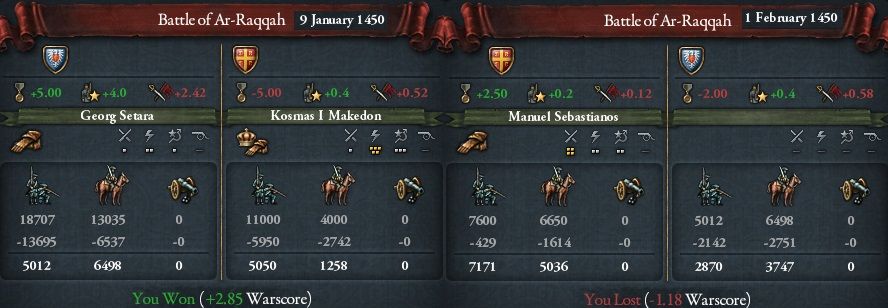AFAIK strong Eurasian empire can try to steer the east asian trade through land.
True. On the other hand India, which is one of the motherlodes, has to go through Gulf of Aden IIRC.
AFAIK strong Eurasian empire can try to steer the east asian trade through land.
Subscribed!
Well, it's fairly obvious that Egypt will have a stranglehold on Asian colonization for a while. Out of interest, what tech groups are everyone?
Looking forward to further installments of this story! It's been excellent so far! :happy:
Allright, I'm here, I'm subbing. Geez you are writing these fast.
You are some writer. I was just expecting a couple sentences to help describe the pictures but you have us a really well-written post explaining everything. I'm really looking forward to the Renaissance in this messed up world.
That North Sea Empire, yo!
Loved the First Part, looking forward this one!
I don't have or played EU3, so I will probably partly discover the game here
Errr...
I'd go east. You're in a good position to subjugate India, and that's a land worth subjugating if I ever saw it!
Mhm. Any colonising he does will have to be in Africa/Asia anyway because there's no way he's getting to America before the Brits.
What tech group are you anyway? I heard that even if you're really advanced, Orthodox always becomes eastern.
It's actually more fundamental than that, due to the way the EUIV Trade System works- the positioning of his capital in Egypt means he CAN'T funnel trade there from the Americas- and trade, in EUIV, is where the real benefits of colonisation come from. Okay, he can funnel trade from... I think California and Mexico? The west coast and the carribean, though, is not a place he can get money from efficiently.
On the other hand, holding so much of Arabia means he might well be able to place a stranglehold on the Gulf of Aden trade node, which means he can benefit from anyone else trying to colonise Asia- that's the trade node EVERYONE has to go through, after all.
in this history, the colonization of the new world was probably a response to the egypto/rhoman stranglehold on asian trade routes.
also does anyone know how the reformation mechanics work in eu4? Part of me wonders how well they would actually fit into a world without such a strong papacy. Although with that said, it could probably be considered a form of religious nationalism with scandinavians and poles using it to break from Catholic Anglicanism. Maybe its led by Martin FitzLuther or something.
You said you were going to upload the save/conversion?
Looks like this should continue to be as interesting as before. Should be interesting to see how EUIV compares.
Might have to get it but it looked far more complicated from the demo... and I'm unlikely to survive long enough to convert a game given how rubbish I seem to be.
Fascinating! Loved your CK2 AAR, looking forward to reading this as well. Definitely subscribed.
Time to secure the southern border and reincorporate the Ethiopians.
i love it. the epic story continues
AFAIK strong Eurasian empire can try to steer the east asian trade through land.
True. On the other hand India, which is one of the motherlodes, has to go through Gulf of Aden IIRC.
it seems too homogenous for a full scale revoltinb4 rebels bring down the Roman Empire!
Oi, that was a tough blow at Aleppo. I assume you won't westernize for a while? Ck2 was awesome, defenitely following.
The likely reason the reformation never fired is that in EUIV it's driven by the actions of nations- certain decisions and choices in response to events drives up a reform desire marker, and at about 95% some churchman nails a set of complaints to a door.
From the sound of things, you only actually have two Catholic nations. A standard EUIV game has many more. Essentially, there just aren't enough Catholic countries to drive the reform desire up sufficiently. *shrugs* Really, that's why my current Roman Empire megacampaign is a Catholic one (not an AAR, although I'm considering it- main issue is that I did cheat a little to make it... a BIT more stable in the beginning, due to the aforementioned Catholic thing)- the fun of the Roman Empire dealing with the Reformation. :3
Would there be anyway to have the reformation occur for the orthodox? Neo-Iconoclasts or something? Although there are really only 2-3 orthodox nations, so that doesnt really drive up reform either

Whelp, first war went... all right, it seems? Your relationships with the byzantines must take quite a hit from those borders.
The likely reason the reformation never fired is that in EUIV it's driven by the actions of nations- certain decisions and choices in response to events drives up a reform desire marker, and at about 95% some churchman nails a set of complaints to a door.
From the sound of things, you only actually have two Catholic nations. A standard EUIV game has many more. Essentially, there just aren't enough Catholic countries to drive the reform desire up sufficiently. *shrugs* Really, that's why my current Roman Empire megacampaign is a Catholic one (not an AAR, although I'm considering it- main issue is that I did cheat a little to make it... a BIT more stable in the beginning, due to the aforementioned Catholic thing)- the fun of the Roman Empire dealing with the Reformation. :3
On province discovery spread with different tech groups: never. Discovery spread is specifically a thing for the same tech group, which kinda sucks in this circumstance. The other issue is that if that North Sea Empire ever takes the Religious Idea Group... well. Purges of Heresy all around.
EDIT: As far as India goes, no, you shouldn't take EVERY province there- but look for the Center of Trade provinces and take those. Between that and a big enough trade fleet, you should be able to steer a respectable amount of trade to Alexandria.
inb4 rebels bring down the Roman Empire!
it seems too homogenous for a full scale revolt
Oi, that was a tough blow at Aleppo. I assume you won't westernize for a while? Ck2 was awesome, defenitely following.
There appears to be no capability to Westernise for... a while. There are only two Western tech nations, and they're on the other side of the continent.
Would there be anyway to have the reformation occur for the orthodox? Neo-Iconoclasts or something? Although there are really only 2-3 orthodox nations, so that doesnt really drive up reform either
That would likely be a separate mod- bit much to ask in this case.
I figure the Reformation would be… unlikely… in this historical situation anyway.
This is brilliant! Consider me subscribed.

I don't really get this picture. On the left one, you lose your entire army but it says you won? Or am I misinterpreting the shields?
EDIT: Never mind, I was looking left-to-right
subbed!
that said, the only thought that comes to mind aside from looking forward to another great AAR is how the scale of the battles kinda feel a lot... more subdued now. Years ago, you had half a hundred thousand men clashing with another half a hundred, now you barely have a full legion :laugh:
It's back! Woo! Burn down Miklagard!

